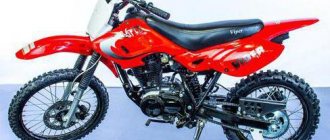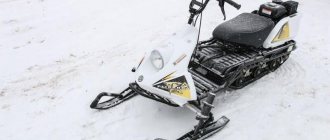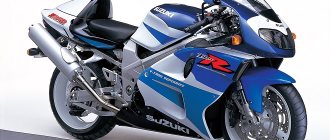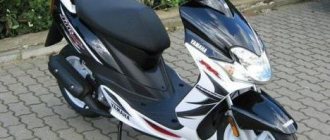Traditional gearboxes of mechanical and automatic types are being replaced by so-called CVTs. These devices are now installed on different types of transport - cars, snowmobiles, ATVs and other motor vehicles. The Safari CVT is reliable and affordable. It has practically no competitors from the presented species in the modern car market. This mechanism has its own operating features, which you need to become familiar with before purchasing equipment with a CVT transmission.
What it is
A device called a variator is designed to make the speed adjustment smoother. This block helps change the gear ratio. Unlike other types of transmissions, it can do this gradually, without sudden jerks. The Safari variator belongs to the type of mechanism with V-belt transmission.
Since 2000, they have been installed on Taiga and Buran snowmobiles. These and other means of small-scale mechanization are produced by the well-known. The CVT is also in demand by other automakers who value ease of maintenance and durability of parts.
How it works
There are several types of Safari variators; they differ from each other only in the weight of the weights. The main part of the mechanism responsible for proper operation is the centrifugal regulator. It is represented by a structure of several elements:
- spring pressure mechanism;
- disk on a movable cone;
- stop;
- driving and driven pulleys;
- weights of a movable cone that rotate on their axes;
- variator shaft;
- variator covers.
Other design features include the fact that the mechanism contains a fixed cone with a stop. It is attached to the shaft using a right-hand thread. Pressure parts with a spring designed to ensure that the moving cone returns to its original state if the engine speed with the Safari variator on the vehicle is reduced.
Each cone is individually balanced; small parts do not require this complex process. When the power plant is operating without load at idle, the driver is advised to ensure that there is a small gap of 1-3 mm between the belt and the moving pulleys. This gap can be corrected using special rings.
Some tips
When installing the Safari variator on a motorized towing vehicle with your own hands, you need to take into account a few tips from professional mechanics. They will help you understand some of the intricacies of the process of adjusting and operating the system.
Kevlar belts almost never slip. Therefore, during the adjustment process, you can slightly reduce the preload of this structural element. In this case, the drive belt will move onto a pulley of a smaller diameter more easily. When the engine speed is low, the vehicle speed will be quite high. This allows you to significantly save fuel.
If the drive belt falls below the discs, the towing vehicle will have a harder time starting. In this case, repairs must be made. The old belt is worn out. It will need to be replaced with a new structural element.
How does it work
The owner who is going to independently repair the variator and maintain it needs to know the principles of its operation. As the process of rotation of the mechanism begins, it is affected by centrifugal force. Here weights play a big role - with their help, the variator cone, which comes into motion, begins to gradually shift. The diameter of the shaft around which the drive belt moves changes. In order to counteract the displacement of the cone in the variator device, a mechanism such as a return spring is installed.
When the number of rotations exceeds 2200 rpm, the opposite action of the pressure spring begins. After reaching this number of revolutions, the drive belt, which has a trapezoidal shape, is pressed using a disk against the movable cone of the variator. The power unit transmits torque to the main shaft of the vehicle. At this time, a smooth decrease or increase in speed occurs.
The principle of operation of the variator
The device of a variator using the example of CFMOTO X4: 1 - drive pulley, 2 - bolt, 3 - driven
pulley, 4 - belt, 5 - washer, 6 - weight block, 7 - weight, 8 - slider.
The variator regulates the speed of the ATV depending on the number of engine revolutions. It consists of two parallel pulleys with movable conical disks or cheeks.
The crankshaft rotates the drive pulley, and from it the torque is transmitted to the driven pulley using a toothed belt. The higher the number of revolutions, the stronger the effect of centrifugal force. The drive pulley disks move closer together, pushing the belt to a larger radius. At the driven shaft, the discs converge, compress the spring, and the belt goes to the center between them, thereby smoothly changing the gear ratio. The spring is responsible for ensuring that the belt is always tensioned. As the rpm increases, the belt is proportionally tensioned, which prevents it from slipping.
Technical specifications
Compared to mechanical analogues, the Safari variator has a relatively small mass. It is distinguished by a simpler design and uncomplicated operation. When fully assembled, the device has the following dimensions:
- 210 mm in diameter;
- total weight - 3.8 kg;
- length 167 mm.
If we compare the Safari with similar CVT gearboxes, they are also inferior to this mechanism. Many of them have greater weight and diameter. Other technical characteristics include - load grip at 2200 rpm, load weight 150 g.
Pros and cons of using an automatic clutch on all-terrain vehicles
Greetings! Both home-made and mass-produced all-terrain vehicles are often equipped with Chinese Lifan engines or their analogues under other brands. These motors are usually installed together with a reduction gearbox and automatic clutch, or with a variator. In both cases, the clutch is automatic; When the engine speed increases, the all-terrain vehicle takes off.
But all-terrain vehicles can easily use a regular clutch, like in a car. Based on my experience in operating a homemade trike from a Ural motorcycle, I will try to highlight the main advantages and disadvantages of an automatic clutch compared to a forced one.
Video on the article:
Let me remind you that initially the tricycle had the original Ural engine, gearbox and, accordingly, clutch. Now it has a Chinese Forza engine (similar to Lifan) with a reduction gearbox and automatic clutch, plus a gearbox from the “classics”. You can read more about the trike in this article. Of course, this is not quite an all-terrain vehicle, but I think the basic principles of control are the same.
Benefits of an automatic clutch
So, without delving into the specifics of the operation of a centrifugal clutch or variator, we list the main advantages of this solution on an all-terrain vehicle:
- Simplicity of design. The clutch operates automatically as a result of centrifugal force, which eliminates the need for hydraulic or mechanical drives. If we take as an example a reduction gearbox with a centrifugal clutch for the Lifan engine, its design is extremely simple. There is almost nothing to break there, except that the disks wear out over time. With a variator it’s a little more complicated.
- The engine does not stall when overloaded. If, say, we start driving a car at low speeds, the engine will most likely stall. In the case of an automatic clutch, this situation is excluded. And this is a huge plus off-road.
- Convenience. There is no need to squeeze the clutch: put on the gas and go, let off the gas and stop or change gear.
Now the disadvantages:
- It is more difficult to control the torque on the wheels. For example, with an automatic clutch, you won’t be able to push the car at idle speed.
- When driving at low speeds, the automatic clutch discs wear out quickly, because The centrifugal force is not enough to compress them, which causes them to slip.
- Inability to instantly disengage the clutch. Until the engine speed drops to idle, the clutch will not disengage. This interferes with changing gears and, for example, trying to get out of a hole while rocking.
These seem to be all the main points regarding the use of an automatic clutch on all-terrain vehicles.
Conclusion
As for my homemade trike, after installing a Chinese motor with a centrifugal clutch, driving off-road became much easier. You can take off in any gear up to third, and the engine will not stall even in difficult conditions, which could not be said about the Ural motor. Of course, there is also the matter of transmission ratios; first gear with the Ural engine was too fast for off-road use.
Write in the comments what you think about using an automatic clutch on all-terrain vehicles.
How to adjust
In its design, which differs slightly from similar devices, the Safari variator has a pulley that is specially adjusted for a trapezoidal belt. It has parameters of 1120*33*14 mm in length, width and thickness, respectively. After final installation of the mechanism on the vehicle engine shaft, a full check of the correct adjustment of the following parameters is required:
- The distance between the belt part and the edges of the cones. To do this, check how much space is left to the edges of the fixed cones. It should be no more than 55 millimeters. Adjustment is carried out by moving the motor in the grooves located below. You also need to additionally check the distance from the driven pulley cones to the belt. According to the regulations, this figure should be no more than 33 mm.
- Drive belt tension. During the procedure, install the drive belt in neutral gear of the motor. Then rotate the driven pulley several times until the drive belt matches the outer diameter. Now you can check how well the belt part is tensioned. This is best done using a bar that is applied to the top surface of the belt. In this case, the deflection of this element should be about 32 mm. After these procedures, the tension is adjusted using three screws, which must be screwed into the threaded holes located on the driven disk.
If it is not possible to perform the correct adjustment, and the distance described in the regulated technical documentation does not meet the requirements, then after adjustment, motorcycles with a Safari variable speed drive will be much more difficult to move away from. This often happens due to wear of one of the elements.
Experts advise to look in advance at the technical characteristics of the drive belt that are installed on this type of variator. Sometimes its size can be 35*14*1118. Then during installation it is imperative to maintain the correct size of the gap between the pulley cones and the edges of the belt. In this case, the belt part must rest on the pulley shaft. When the gap is incorrect or there is no gap at all, additional rings must be installed for proper adjustment. They are usually placed between the shaft protrusion and the stop. In some cases, a belt with a larger width is installed. According to technical parameters, the use of such spare parts is allowed. If everything is done correctly, then additional adjustment of the variator is not required.
Maintenance intervals
Devices such as Safari variators have a long service life. However, in order for the mechanism to last for a long time, regular maintenance must be performed. Experts advise resorting to such procedures after the following periods:
- After 3 thousand kilometers, lubricate the shaft located under the split bushing. To perform this procedure, materials such as “Litol-24” or “Ciatim-200” are suitable.
- After 6 thousand km, check the wear of the liners and bushings that are located in the axles of the weights.
You can find out how damaged parts such as weight bushings are by checking the radial play indicator. If it is already more than 1 mm, then parts need to be replaced. Damage to the liners can be easily checked by the size of the gap between the elements and the guide ribs of the drive cone. The error allowed is no more than 1.5 mm.
In addition, it is imperative to check the condition of the centrifugal regulator shaft. After prolonged intensive use, a small layer of rubber remains here from the burning of the trapezoidal drive belt. This defect is very easy to eliminate if you use a cotton rag soaked in gasoline. Subsequently, it is recommended to warm up the engine in neutral beforehand to prevent such a problem from occurring.
Possible malfunctions and methods for eliminating them
During operation of the Arctic variator, malfunctions “problems” may occur caused by wear of parts, violation of adjustments and maintenance rules.
When replacing rubbing elements, weights, rollers, friction liners in a timely manner, the following basic rules should be strictly followed:
By following these recommendations, you will increase the service life of this product.
| Position | Details | Quantity |
| 1 | Stationary cone | 1 |
| 2 | Movable cone | 1 |
| 3 | Stop spring | 1 |
| 4 | Lid | 1 |
| 5 | Emphasis | 1 |
| 6 | Weight | 4 |
| 7 | Video clip | 4 |
| 8 | Weight axis | 4 |
| 9 | Roller axis | 4 |
| 10 | Friction liner | 4 |
| 11 | Friction bearing spring | 2 |
| 12 | Resistant ring | 4 |
| 13 | Self-locking nut | 4 |
| 14 | Weight axle bushing | 8 |
How to remove a pulley
The drive pulley plays a very important role when repairing the Safari variator. With its help, torque is transmitted from the motor to the wheel axles. In order to install this spare part, you need to screw the pulley onto the shank located on the crankshaft of the power plant. To do this, the movable competition is moved in such a way that a special hole on the shaft can be accessed. After this, tightening is done using a wrench. Now you can install the belt and variator housing. The snowmobile's instruction manual describes in detail how to do this.
If it is necessary to remove the pulley from the shank, then this operation must be performed in the following order:
- Remove the casing.
- Remove the variator belt.
- Move the movable cone away. Then the hole for the knob on the shaft will become accessible. Using a special spacer, stop the cone to prevent reverse movement. It should be placed between the stop and the movable cone.
- Place a metal object under the electric start gear tooth to prevent the engine crankshaft from turning.
- Unscrew the shaft with a screw.
Features of replacing variator belts on Yamaha snowmobiles
Replacing the variator belt on Yamaha snowmobiles has its own characteristics. So, let's begin. First you need to put the snowmobile into parking mode. The “parking” function allows you to operate the snowmobile without turning the pulleys. On approximately 70% of all snowmobiles that include Yamaha snowmobiles, the CVT shifts inward along the guides. To remove the variator, you need to turn it with a key and at the same time press the variator a little, at which point the variator belt loosens. Fixing the variator by hand in this position, remove the belt itself. The more the variator is moved inward, the more space remains for removing the belt.
Next, we install a new belt, the installation of which begins only through the crankshaft pulley, and then through the rear variator. To fully thread the belt, we perform the same operations as before. We simply press on the variator, as a result of which the necessary space appears to completely fill the belt. Upon completion of “refueling” the variator belt, a protective casing is installed. To test the new belt, do not forget to remove the snowmobile from the “parking” position, so that when starting the engine you do not burn the new belt. Usually, even beginners can replace the variator belts on Yamaha snowmobiles the first time.
In addition to the variator and its belt, experienced snowmobilers immediately check the condition of the track, or rather its tension. Its weakening is indicated by a dull noise while riding a snowmobile. To tighten the track, you need to immediately lift the “back” of the snowmobile. The sag gap is determined between the rail and the track support. (The gap is about 50 mm). Having reached the guide rollers, we loosen the fastening bolts. We also loosen the locknuts. The greater the sag, the more you need to tighten the fastening bolts. Once the required tension is achieved, you need to secure the roller using locknuts. This process is required for both rollers. You need to understand that as a result of excessive tension, power development drops significantly. In addition, this may lead to rapid wear of rear suspension parts.
Disassembling the regulator
When disassembling a device such as a regulator, it is necessary to observe the precautions specified in the technical documentation. Under no circumstances should lubricant be allowed to come into contact with the conical surface of the discs. You can disassemble the device yourself if you follow the correct sequence:
- Remove the regulator from the vehicle.
- Clamp the cone in a vice or otherwise fix it motionless.
- Unscrew the cone with the lid and stop.
- Remove the bolts that connect the cover and the movable cone. You need to carefully hold the cover while unscrewing the last bolts. Underneath there is a compressed spring that can fire.
- Disassemble the stop - remove all gaskets, wash the rollers and axles in kerosene.
After repair, the regulator is mounted in the reverse order. Damaged gaskets on the stop are replaced with new ones.
Flaws
According to experts, this device has virtually no disadvantages. However, Safari CVTs also have weaknesses:
- adjustment that is difficult for a non-professional to make;
- weak V-belt that cannot withstand moisture;
- rapid wear of the trapezoidal drive belt.
When water gets on the V-belt, the quality of adhesion to the pulleys decreases and the traction force deteriorates, and the surface on the drive belt quickly wears out when the torque of the power unit is exceeded.
Adjusting snowmobile track tension
How to properly tension and adjust a snowmobile caterpillar , because adjusting the caterpillar affects the durability of its use, fuel consumption, speed and cross-country ability of the snowmobile. The main points in adjusting the caterpillar are: tension and centering of the web; these points are connected to each other, like a thread with a needle. Especially often, the need to adjust tracks arises on new snowmobiles, since parts of the suspension, the hooks of the pair: track/drive sprockets are grinding in, and the track web is being pulled out. The adjustment, regardless of the brand of snowmobile, should be carried out on the suspension and track warmed up while in motion. Those. immediately after running a snowmobile in natural conditions. Also, before adjusting, it is necessary to clear the suspension from snow and ice and check the condition of the suspension. These requirements are mandatory.
- The influence of a tight track on the behavior of a snowmobile: the snowmobile starts hard, slowly picks up speed, the engine can get hot - that is, additional effort is spent on rotating the caterpillar. In addition, in snowmobiles with slip suspension, due to excessive friction, intensive wear of the slips occurs.
- Weak tension of the caterpillar leads to the drive shaft sprockets slipping relative to the caterpillar during intense acceleration or load, the caterpillar also has the ability to move, “walks” and often does not rotate within the treadmills, the slips rub the rubber, moving not along the brackets, tearing the perforation (blizzard) , can break the spokes, there is wear on the side edges (the cord is climbing), the road wheels turn over (buran), the caterpillar falls off under lateral loads.
Main competitors
In addition to Safari variators, other types of devices are installed on ATVs and snowmobiles. The main competitors in the spare parts market are:
- "Alpina";
- "Arctic";
- "Leopard".
Among these mechanisms, only Bars can compete fully. It is more revving and is suitable for those people who like to reach high speeds on snowmobiles. The remaining representatives - "Arctic" and "Alpina" - are slower and heavier.
Reviews
Now you can find different responses about installing Safari variators and adjusting the mechanism. They are left not only by vehicle owners, but also by repair specialists. Professional auto technicians praise the quality of the components, but recommend checking the spring and crosspiece of the variator before purchasing a used device. There should be no defects on them, then there will be no problems with maintenance.
The “Safari” variator, according to reviews, is liked by customers. Experts warn that the mechanism will last longer if you do not start the engine with the belt and protective cover removed. Otherwise, the pulley may turn away from the shaft and partial repairs of the unit will have to be performed.











